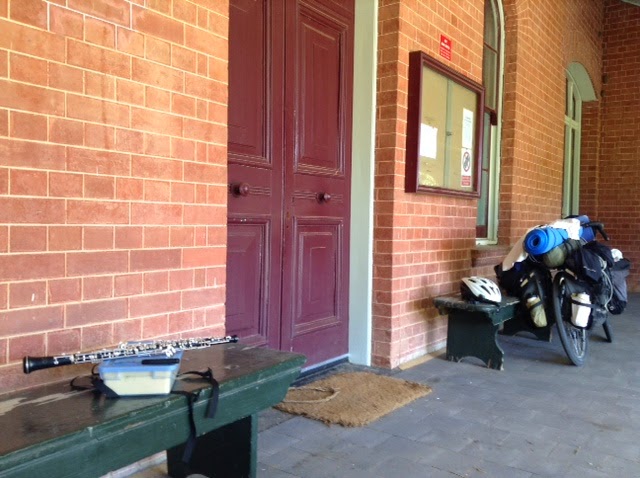My first night in Hay, I chose to stay in the free camping area near the river. Most of it was just bare dirt parking areas for caravans, but there was a grassy picnic area, without any really explicit "No Camping" signs. There were, however, some big floodlights overlooking it, so I waited until dark before putting up my tent. Sure enough, just as the last twilight faded, two huge mercury-vapor lights lit the place up like a stadium, so I had to camp in the dirt and thorns.
I spent the next day in Hay. It was a warm day on the weekend, so the sports ground, my usual oboe spot, was occupied. However, the courthouse was deserted, and had a great veranda with benches, so I spent much of the day there. No one bothered me.
 |
| Hay Courthouse |
 |
| Hay Courthouse Veranda |
That night I stayed in the caravan park instead of dirt and thorns. My neighbors, a retired couple with a small tent, were on their way from Adelaide to the Snowy Mountains to do some hiking.
The route to Booligal the next day was pretty bleak, between two rivers, but there was a nice tailwind. Some of the vegetation looks like the sagebrush of the US Southwest. Along the way was "One Tree", where I had lunch next to the road, in the sun.
 |
| En Route to Booligal |
 |
| What Tree? |
Booligal consists of a pub/hotel and a small sports ground. The locals sitting outside the pub had seen me coming far up the road, as it's exceedingly flat. I had a shower by the pub for $2, and when I asked the lady who runs the place if there was a basin in which to wash my clothes, she insisted in putting them in her washer. I practiced for a while at the sports ground, then had dinner at the pub. When I was done with dinner, the lady delivered my dry clothes to the table! I camped at the sports ground, of course. There was even a full rain water tank there.
The next day, another installment on those tailwinds came due. It was only 77 km east to Hillston, but it was hot, there was a strong headwind, and the gravel road was in terrible shape, with lots of soft, sandy stretches. I started with 6 liters of water, which wasn't enough. It does start to look a little greener towards Hillston, a sign of increasing average rainfall towards the east.
After arriving in Hillston, I pulled three thorns out of my tires, no doubt the result of pushing through the brush along that gravel road. The tires seemed to be OK.
Hillston is a lush oasis compared to all that dry country, so I decided to spend the next day there. When I passed through in 2004, I met a retired farm couple, Jenny and Joe Rose. I tracked them down again, and had a nice visit. Their farm was near Hillston, and I forget how many thousands of acres, but it was huge, as that's what it takes in this country. Later, they invited me to a potluck dinner with some of their friends.
 |
| Joe and Jenny Rose (center) and friends |
Meanwhile, the back tire was NOT OK. The first puncture of the trip, a thorn I had missed earlier.
The ride to Lake Cargelligo the next day was more pleasant. There was a tailwind, the road was sealed, and just east of Hillston trees appeared. My lunch stop was in the shade, for a change! Many of the trees were introduced pines of some sort.
 |
| Trees! |
The lake in Lake Cargelligo is artificial, but probably didn't take nearly as much diesel fuel to make as the one in Moulamein. It was an ephemeral lake, filling only when the Lachlan River flooded, but was modified to stay full most of the time. It's quite large, though shallow.
I spent the next day in Lake Cargelligo. The caravan park had a nice shelter, with good shade and a table, so I got everything set up to work on oboe reeds. Then the sprinkler came on, hosing down everything before I could get it out of the way. I had to find a place in a nearby park to dry everything out. It seems the city pumps water from the lake to water various places sequentially, and it was time for the caravan park. Whoever opened that valve no doubt had no idea it would flood an oboe operation.
That day, I met a cycling couple from the Netherlands, Ellis and Willem. They had been on the road for nearly two years, and had cycled all through Europe, Asia, and around Western Australia, some 33,000 km so far.
 |
| Ellis and Willem |
The ride to Condobolin was long, 102 km, but quite easy. There was a tailwind part of the way, and the 16 km of gravel road wasn't bad. I found another shady spot in a dry river bed for lunch.
When I was in Condobolin in 2004, a reporter for the local weekly paper interviewed me and published a front-page article and photo. I had arranged to do another interview for them, so I met Lara, the editor/reporter, when I arrived. (She was still in high school in 2004.) She could have written about Ellis and Willem, too, if she'd known they were in town the day before.
I'm spending another night in Condobolin. My next stop, Forbes, is another 100 km to the east, and there's a strong easterly wind today. Unfortunately, it's supposed to blow that way tomorrow, too, so it may be a long day.
No comments:
Post a Comment